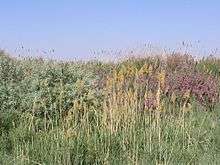Tugay
Tugay[lower-alpha 1][lower-alpha 2] is a form of riparian forest or woodland associated with fluvial and floodplain areas in arid climates. These wetlands are subject to periodic inundation, and largely dependent on floods and groundwater rather than directly from rainfall. Tugay habitats occur in semi-arid and desert climates in central Asia. Because Tugay habitat is usually linear, following the courses of rivers in arid landscapes, Tugay communities often function as wildlife corridors. They have disappeared or become fragmented over much of their former range.[1][2]

Distribution
The centre of the range of Tugay vegetation is the Tarim Basin in north-western China, where the Tarim Huyanglin nature reserve in the middle reaches of the Tarim River holds the largest areas of intact Tugay forests, with a 1993 estimate of about 61% of the total. The Central Asian countries hold another 31%, with smaller areas remaining in the Middle East and Pakistan.[1] Tugais also occur in the Caucasus.[3]
Vegetation

Close to rivers and where groundwater levels are shallow, the vegetation is usually dominated by poplars (especially Populus euphratica)[3] and willows such as Salix songarica. Where the forest has been disturbed, other species such as tamarisk, sea-buckthorn and oleaster will grow. Herbaceous plants include reeds, common spike rush, jointleaf rush, fleabane, cocklebur and thorn apple. Grass tugai vegetation is dominated by Phragmites australis, Calamagrostis and Typha.[2] Where the groundwater is deeper, oaks and elms will dominate.[4] The principle causes for the loss of tugai vegetation include dam construction, tree cutting, grazing, and agriculture.[2]
Notes
- From Bashkir: туғай, romanized: tuğay
- Also spelt or romanized as Tugai, Tughay, Tugae, Tougaï, Toogay, etc.
References
- Thevs, Niels (2005). "Tugay vegetation in the middle reaches of the Tarim River – Vegetation types and their ecology". Archiv für Naturschutz und Landschaftsforschung. March 2005: 63–84.
- Treshkin, S.Y.; Kamalov, S.K.; Bachiev, A.; Mamutov, N.; Gladishev, A.I.; Aimbetov, I. (1998). Present status of the tugai forets in the lower Amu-Dar’ya Basin and problems of their protection and restoration. Pages 43-53 in Ecological Research and Monitoring of the Aral Sea Deltas. A Basis for Restoration. Paris, France: UNESCO.
- Heptner, V. G.; Sludskij, A. A. (1992) [1972]. Mlekopitajuščie Sovetskogo Soiuza. Moskva: Vysšaia Škola [Mammals of the Soviet Union. Volume II, Part 2. Carnivora (Hyaenas and Cats)]. Washington DC: Smithsonian Institution and the National Science Foundation. pp. 1–732.
- British Petroleum. 2002. "Ecological Baseline Report". BTC Pipeline ESIA, Azerbaijan. Retrieved 2013-03-30.